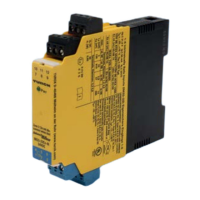4.3.2 Signal transmission
Signal transmission on 2-channel devices: The input signal is transmitted 1:1 to the associated output.
4.3.3 Signal doubling
Signal doubling: The input signal of channel 1 is transmitted 1:1 at both outputs.
4.3.4 Line monitoring
A wire break is detected at an input current <3.6mA and a short circuit at an input current >21.5mA in accor-
dance with NE requirements, and indicated accordingly as an output value.
4.3.5 Fault acknowledgement
Faults do not have to be acknowledged. If the fault is rectified, the device automatically resumes operation.
4.4 Types of faults and failures
Failures must be classified in conjunction with the application into safe (non-hazardous) and unsafe (hazardous)
failures. You as the operator are responsible for this.
NOTE
Turck must be notified immediately of all damage that was caused by a dangerous undetected failure.
A dangerous failure is present if an internal error has caused
■
the device not to respond when required by the process (e.g. does not switch to the defined safe state) or
■
the output current – as opposed to the input current – changes by more than 2 % of the end value.
4.5 Safety characteristic values
4.5.1 FMEDA assumptions
The safety-related characteristic values were determined based on an FMEDA in accordance with IEC 61508. The
FMEDA is based on the following assumptions:
■
The failure rates are constant.
■
The mechanical wear is not considered.
■
The propagation of failures is not relevant.
■
The MTTR repair time after a safe failure is 8 hours (replacement of the device).
■
The device is operated in low demand mode.
■
The failure rates of an external power supply are not considered.
■
The HART® protocol is not used during normal operation but only for the setup, calibration and diagnostics of
the field devices and is not part of the safety function
■
Only one input and one output are part of the safety function.
■
The failure rates used are the Siemens standards SN 29500 at 40 °C .
■
The second channel of a device cannot be used to increase the HFT hardware fault tolerance.
■
The ambient conditions correspond to an average industrial environment, as defined in MIL-HNBK-217-F or IEC
60654-1, Class C (sheltered location).
–
The ambient temperature is normally 40 °C.
–
A safety factor of 2.5 must be applied for ambient temperatures of 60 °C and frequent temperature fluctua-
tions
■
The user program in the safety controller is designed so that a wire break (fail low failure) and short circuit (fail
high failure) are detected irrespective of whether it is a safe or dangerous failure in relation to the safety func-
tion.

